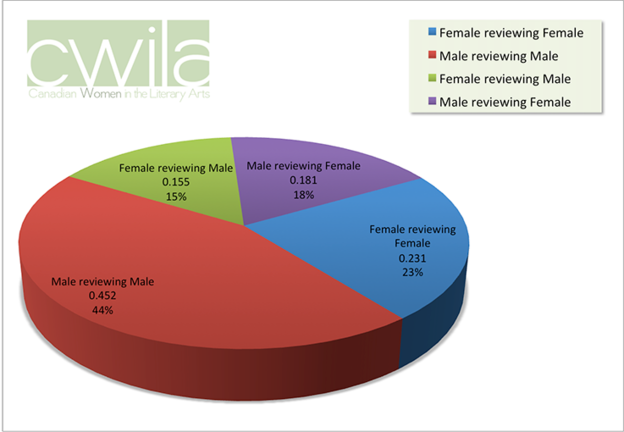CWILA to the avant-garde

A new web project was launched last week: CWILA—Canadian Women in the Literary Arts—which offers a range of research on and responses to (including excellent interviews) the current interface of gender and critical reception. The work of over 70 Canadian women poets, novelists and scholars, at the core of the project are a series of colourful graphs and pie charts—the results of extensive research—that show just how slanted reviewing presently is in the country, in terms of how many more male-authored books receive critical attention than female-authored books (the total number of books published by men and women are remarkably equal).
Gillian Jerome, one of the project organizers, writes in her “Introduction”:
“The CWILA Numbers 2011 make clear that if we hope to foster a culture in which women’s intellectual contributions are valued as much as men’s, more critical attention must be paid to books written by women.”
Ethnographer Lorri Neilsen Glenn glosses the statistics:
“Like fish, we can’t always see the water we swim in. Western colonialist and patriarchal assumptions can hold sway in language despite our efforts: it’s a truism in contemporary sociology that objectivity is just another term for dominant subjectivities…. The world of reviewing is a microcosm of the larger story of women and language. Women write and publish as frequently as men in Canada, and yet women’s books are less frequently reviewed, and women reviewers are less frequently published.”
What’s more depressing, the fact that Jerome and Neilsen Glenn are even having to point this out, now, in 2012, or what the skewed numbers starkly reveal (one leading Canadian journal’s reviews are, in 2011, 76% focused on male-authored works)? Then again, this is the era in which a female State legislator can be censored for using the word “vagina” during an anti-abortion debate.
I mentioned, in my last post, that I’m of a generation of poets and critics who benefitted from second wave feminism. Crucial instructors in university were feminists. The poets I would list among my key influences include as many women as men, with possibly no poets more important to me (different as they are) than Phyllis Webb and Susan Howe. Key “contemporaries”—poets I’ve also learned from, and whom I see my own work as unfolding amongst in crucial ways—include (just sticking with a selection of Canadians for now) Lisa Robertson, Lissa Wolsak, Rachel Zolf, Sina Queyras, Oana Avasilichioaei, Rita Wong, Larissa Lai, Cecily Nicholson and Christine Leclerc. All are poets I have written on, reviewed, or taught in the classroom.
I’m only noting this because I think it’s fairly typical: any male poet/critic now would list the work of numerous female poets amongst their key, shaping influences. But then—why the CWILA numbers? Why the continued slant towards male-authored books under review? My answer will only be partial, and will only focus on, for lack of a better term, the “avant-garde,” the workings of which I’m most familiar with.
I have, I’m sorry to say, seen male poets, in editorial and curatorial positions, reject work by women based upon what they claimed were “purely aesthetic” grounds. That is, the work was deemed “not interesting,” formally “too conventional.” No one likes to admit it, but it’s there—“innovative work” is too often, not to mention inaccurately, gendered “male,” and narrowly defined.
The reasons why this might be so are complex, but have a lot to do with the avant-garde being, in its origins, a largely male-preserve, too often incorporating an ethos of “out-maneuvering” competitors, and thus attracting young men socialized for similar competiveness. There’s also the spirit of capitalism looming everywhere over this—the presence of an ethos that prides itself on innovation for innovation’s sake (which of course masks, once again, the idea of a “competitive edge,” and a greater accumulation of “assets”). I have, at times, fallen for all of this myself.
However, I want to focus, in conclusion, on another facet of the issue. To me a crucial potential in the idea of an “avant-garde” gets missed when it becomes focused on a narrow competitive aestheticism. There are other “histories” of the avant-garde.
The avant-garde was always part of a social/aesthetic dialectic—the “cultural wing” of the social and utopian project (Jeff Derksen: “The Future has always been a cultural project”). It participates most fully in this dialectic when it is active in the context of communities—when it is part of the full expression of a shared social project. Too often the avant-garde dismisses allied cultural formations on artificially inflated and policed “aesthetic” grounds—for being “merely social.” Yes, I personally am most excited by work that is both aesthetically and socially “radical,” oriented towards change in both its form and its content. But I will ever be a supporter—and often enough I am a producer of—work that falls more fully on one side of the other of this dialectic. The key is the network that brings the aesthetic and social into dialectical interaction. The key is to see and express solidarity with the shared social project of fostering change. The key is in being a good ally to allied movements and formations in neighbouring zones. And it’s just this that so often gets lost.
CWILA, and the appeal it makes, is just this—a call for solidarity. The interviews the website hosts, many of them with allied male poet/critics, suggest this call is starting to be heard.
Neighbouring zones